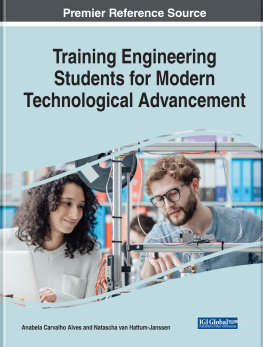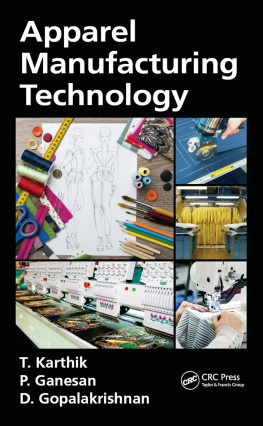
Industrial Engineering
Foundations
LICENSE, DISCLAIMER OF LIABILITY, AND LIMITED WARRANTY
By purchasing or using this book (the Work), you agree that this license grants permission to use the contents contained herein, but does not give you the right of ownership to any of the textual content in the book or ownership to any of the information or products contained in it. This license does not permit uploading of the Work onto the Internet or on a network (of any kind) without the written consent of the Publisher. Duplication or dissemination of any text, code, simulations, images, etc. contained herein is limited to and subject to licensing terms for the respective products, and permission must be obtained from the Publisher or the owner of the content, etc., in order to reproduce or network any portion of the textual material (in any media) that is contained in the Work.
Mercury Learning And Information (MLI or the Publisher) and anyone involved in the creation and writing of the text and any accompanying Web site or software of the Work, cannot and do not warrant the performance or results that might be obtained by using the contents of the Work. The author, developers, and the Publisher have used their best efforts to insure the accuracy and functionality of the textual material and/or information contained in this package; we, however, make no warranty of any kind, express or implied, regarding the performance of these contents. The Work is sold as is without warranty (except for defective materials used in manufacturing the book or due to faulty workmanship).
The author, developers, and the publisher of any accompanying content, and anyone involved in the composition, production, and manufacturing of this Work will not be liable for damages of any kind arising out of the use of (or the inability to use) the textual material contained in this publication. This includes, but is not limited to, loss of revenue or profit, or other incidental, physical, or consequential damages arising out of the use of this Work.
The sole remedy in the event of a claim of any kind is expressly limited to replacement of the book, and only at the discretion of the Publisher. The use of implied warranty and certain exclusions vary from state to state, and might not apply to the purchaser of this product.
Industrial Engineering
Foundations
Bridging the Gap between Engineering and Management
Farrokh Sassani , Ph.D.
The University of British Columbia
Mercury Learning and Information
Dulles, Virginia
Boston, Massachusetts
New Delhi
Copyright 2017 by Mercury Learning And Information LLC. All rights reserved.
This publication, portions of it, or any accompanying software may not be reproduced in any way, stored in a retrieval system of any type, or transmitted by any means, media, electronic display or mechanical display, including, but not limited to, photocopy, recording, Internet postings, or scanning, without prior permission in writing from the publisher.
Publisher: David Pallai
Mercury Learning And Information
22841 Quicksilver Drive
Dulles, VA 20166
www.merclearning.com
1-800-232-0223
F. Sassani. Industrial Engineering Foundations.
ISBN: 978-1-942270-86-7
The publisher recognizes and respects all marks used by companies, manufacturers, and developers as a means to distinguish their products. All brand names and product names mentioned in this book are trademarks or service marks of their respective companies. Any omission or misuse (of any kind) of service marks or trademarks, etc. is not an attempt to infringe on the property of others.
Library of Congress Control Number: 2016953727
161718321 Printed in the USA on acid-free paper.
Our titles are available for adoption, license, or bulk purchase by institutions, corporations, etc. For additional information, please contact the Customer Service Dept. at 800-232-0223(toll free).
All of our titles are available in digital format at authorcloudware.com and other digital vendors. The sole obligation of Mercury Learning And Information to the purchaser is to replace the book, based on defective materials or faulty workmanship, but not based on the operation or content of the product.
To
the loving memory of my father,
the resilience of my mother,
and
my family, from whom I borrowed the time.
CONTENTS
Preface
As an applied science, industrial engineering embraces concepts and theories in such fields as mathematics, statistics, social sciences, psychology, economics, management and information technology. It develops tools and techniques to design, plan, operate and control service, manufacturing, and a host of engineering and non-engineering systems. Industrial engineering is concerned with the integrated systems of people, materials, machinery, and logistics, and ensures that these systems operate optimally and efficiently, saving time, energy, and capital. An industrial engineer, or an engineer equipped with the tools and techniques of industrial engineering is the professional who is responsible for all these tasks.
This book aims to expose the reader at an introductory level to the basic concepts of a range of topics in industrial engineering and to demonstrate how and why the application of such concepts are effective.
The target audience for this abridged volume encompasses all engineers. In other words, the book is written for motivated individuals from a broad range of engineering disciplines who aim for personal and professional development. They would benefit from having a foundational book on important principles and tools of industrial engineering. They would be able to apply these principles not only to initiate improvements in their place of work but also to open up a career path to management and positions with a higher level of responsibility and decision-making.
The level of coverage and the topics included in this book have been distilled from over thirty years of teaching a technical elective course in industrial engineering to non-industrial engineering students in their final year of studies. From direct and indirect feedback from the students on the usefulness of various industrial engineering methods in their work, the course content has evolved to what is now presented as a book.
In writing this book, I am most grateful to Dr. Mehrzad Tabatabian, from the British Columbia Institute of Technology, for his encouragement, sharing his book-writing experiences, and putting me in contact with a wonderful publisher, Mr. David Pallai, who supported and provided guidance throughout the effort. I am also indebted to my colleagues in the Mechanical Engineering Department at the University of British Columbia: Professor Peter Ostafichuk and Mr. Markus Fengler for giving me invaluable advice about writing a book, and I deeply acknowledge a special debt of gratitude to Professor Tatiana Teslenko for graciously editing and proofreading the manuscript.
This is an opportune time to thank Ms. Aleteia Greenwood, Head of UBC Woodward Library and Hospital Branch Libraries, for her advice and expert assistance in the literature search and library matters for many years. I also would like to extend my appreciation to my graduate students Morteza Taiebat, Abbas Hosseini, and Masoud Hejazi for their tolerance. Last, but not the least, I express my heartfelt gratitude to my family for their patience, encouragement, and support.
F. Sassani
November 2016
Next page






